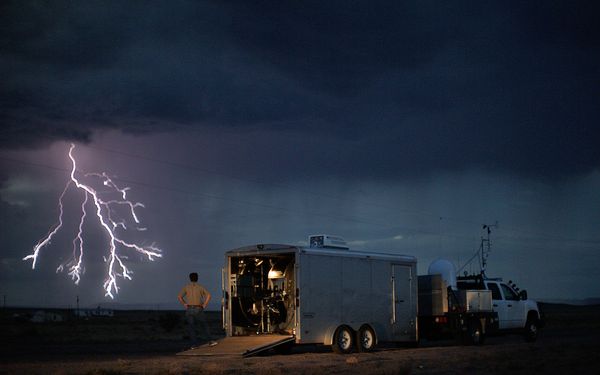Are Storm Chasers 'Crossing the Line'?
A weather researcher looks on as the sky lights up with a cloud-to-ground lightning strike.
As deadly tornadoes spun across parts of central Oklahoma on May 31, 2013, the National Weather Service office in Norman urged residents to find immediate shelter.
"If you are stuck in traffic on I-35, you are in danger. Please try to get to a building or safe shelter," NWS-Norman tweeted.
At least 60 storm chasers stayed on the roads, heading directly toward the tornado itself. Radar imaging posted on Twitter Friday night shows that as the deadly El Reno twister touched down, several cars were precariously close to the tornado core.
Three of those storm chasers lost their lives. Acclaimed researcher Tim Samaras; his son Paul, a videographer; and chaser Carl Young were among those killed by the EF-5 tornado.The Weather Channel's Mike Bettes and two others were injured in the same twister when their car was tossed 200 yards. Reed Timmer, who is featured on the Discovery Channel program Storm Chasers, escaped without injury, but his armored car—Dominator 2—had its hood torn off by the twister.
"If anything, the events of Friday evening demonstrate storm chasers need to back off," wrote Washington Post meteorologist Jason Samenow. "For too long, too many chasers—both professional and amateur—have been crossing the line."
The History of the Chase
Modern storm chasing began in the 1950s, when trackers like David Hoadley and Neil B. Ward started collecting data from area weather offices to predict where tornadoes would touch down. Two decades later, the University of Oklahoma launched the Tornado Intercept Project, and tornado chasing became a research technique used in academia.
For the past 40 years, storm chasers from across the Midwest have obsessively monitored weather reports and forecasting models to predict where tornadoes might touch down. The chasers drive thousands of miles across the Plains in search of severe weather conditions. Many are there to gather key data—things like humidity, temperature, and wind speeds—from inside the tornado itself.
Other chasers take jaw-dropping footage for broadcast on local television reports, which then warn folks to make their way toward a tornado shelter. Oklahoma's local TV stations have a history of providing early warnings for people in a storm's path to take shelter—which ends up saving lives.
"In order for people to take action, they like to know that there's a tornado on the ground," says Samenow. "Three out of every four tornado warnings are false, and research has demonstrably shown that people are more likely to take action if they can see a tornado coming at them."
Where Is the Line?
The debate then, says Samenow, is not about whether storm chasing itself should exist—it is valuable from both a research and a safety perspective—but about how close chasers should be to a tornado to collect footage or data.
"There's a strong feeling from veterans in the chasing community that the industry is heading in a dangerous direction, given the pressures to get so close to a storm," he says. "It's become, 'Who can get the closest? Who can get the most dramatic footage?' The fears have been long held that someone would get hurt or killed in the process."
Samenow says that no one expected that the casualty would be a veteran chaser like Samaras, who understood the dangers of tornadoes, knew how unpredictable they can be, and yet needed to be close to them to collect vital data for research.
"Things like pressure and temperature and humidity—there's no other way to make these measurements other than to make measurements in the tornado itself," says Howard Bluestein, a meteorology professor at the University of Oklahoma. "You need to be on the ground."
Bluestein, who has spent the past 30 years chasing tornadoes, says researchers understand and know the risks involved in their line of work, but amateur thrill seekers without the proper training shouldn't go out into the field.
"It's dangerous to have a lot of storm chasers out there because you create traffic jams near a twister and then it's impossible to get out of the way," he says. "With so many cars in an area, it becomes impossible to get out of the way if something happens."
Samaras commented on the growing number of storm chasers in an interview he gave to National Geographic in May.
"We run into [storm chasers] all the time," he said. "On a big tornado day in Oklahoma, you can have hundreds of storm chasers lined up down the road ... We know ahead of time when we chase in Oklahoma, there's going to be a traffic jam."
Growing Community, Growing Danger
Bluestein says the storm-chasing community has grown considerably since he started teaching at the University of Oklahoma in 1976. Hobbyists inspired by TV documentaries and movies like Twister make their way across the state, carrying photography equipment and little else. Some are trained storm spotters who have volunteered to provide the National Weather Service with information about severe weather incidents where they live. But a growing number are out in the field to take pictures and video—and they have state officials worried.
"We have seen a growing number of storm chasers, amateur and otherwise—especially in the rural areas," says Captain George Brown, a spokesperson for the Oklahoma Highway Patrol. "We're not sure if the benefits [of chasing] outweigh the risk."
After Samaras's death, the National Oceanic and Atmospheric Administration (NOAA) issued the following statement:
"Scientific storm intercept programs, though they occur with some known measure of risk, provide valuable research information that is difficult to acquire in other ways.
We know storm chasing is also done by local government and media personnel who provide valuable warning information, and by amateur storm chasers who wish to see and photograph storms. We encourage all who chase to do so as safely and as responsibly as possible in order to avoid danger for themselves and all those threatened by tornadoes."
But the only way to make storm chasing safer is to enjoy it from a distance, says Jeff Masters, the director of meteorology at Weather Underground, who wrote a detailed post about Samaras's death.
"How do you [convince] people to stay off the roads?" he asks. "One thing this disaster may bring about is an increased awareness that this is a dangerous pursuit and that it should be left up to dedicated professionals."
But Masters, who has had several close encounters while working as a flight meteorologist during hurricanes, says even professionals can become lax.
"After a bunch of years of getting near dangerous weather, you take it for granted that you're invulnerable," he says. "And you need the science, obviously—so you take the risks for granted, a little bit."
Every storm chaser, he says, should follow Murphy's Law.
"Anything that can go wrong, will go wrong," he says. "After every chase, you should be reviewing the chase to see if you can do this even more safely."
Melody Kramer
National Geographic News
Published June 4, 2013












